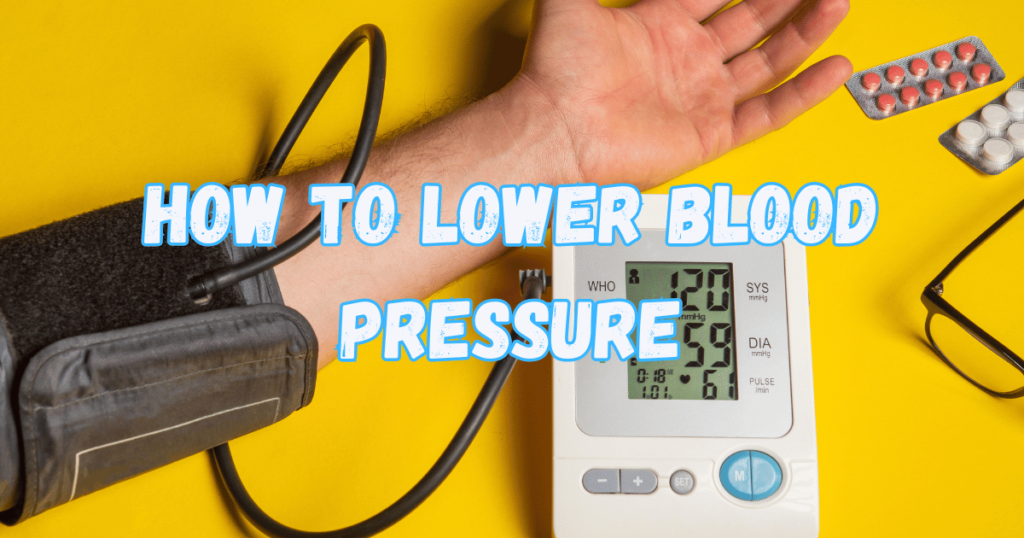Before It’s Late: How to Lower Blood Pressure
How to Lower Blood Pressure, High blood pressure, also known as hypertension, is a silent but significant health concern affecting millions of Americans. It often goes unnoticed until it leads to more severe health issues like heart disease, stroke, and kidney failure. Understanding how to lower blood pressure is crucial for maintaining a healthy lifestyle. This article aims to provide simple, actionable advice to help you manage and reduce your blood pressure.

Understanding Blood Pressure
To effectively manage and lower blood pressure, it’s crucial first to understand what it is and why it matters. Blood pressure is essentially the force that your blood exerts against the walls of your arteries as it circulates through your body. This pressure is vital because it helps move blood around, carrying essential nutrients and oxygen to various parts of your body.
How is Blood Pressure Measured?
Blood pressure is measured in units called millimeters of mercury (mmHg) and is given by two numbers. These two numbers are:
- Systolic Blood Pressure: This is the first (higher) number. It represents the pressure in your blood vessels when your heart beats. It’s the moment when your heart pushes blood out into the arteries.
- Diastolic Blood Pressure: This is the second (lower) number. It indicates the pressure in your blood vessels when your heart is at rest between beats. This is when your heart is refilling with blood.
What Do the Numbers Mean?
- Normal Blood Pressure: A typical blood pressure reading is around 120/80 mmHg. The ‘120’ represents the systolic pressure, and the ’80’ represents the diastolic pressure.
- High Blood Pressure (Hypertension): If these numbers are consistently higher (usually 130/80 mmHg or above), it indicates hypertension. This means your heart is working harder than normal to pump blood, which can strain your heart and damage your arteries over time.
- Low Blood Pressure (Hypotension): On the other hand, if the numbers are lower than normal (typically below 90/60 mmHg), it’s referred to as hypotension. This might mean not enough blood is reaching your organs.
Why is Blood Pressure Important?
Maintaining healthy blood pressure is crucial because it ensures that your body’s tissues and organs receive enough blood and oxygen to function correctly. High blood pressure can lead to various health problems, including heart disease, stroke, and kidney issues, while low blood pressure can cause dizziness and fainting, and in severe cases, can be life-threatening.
Lifestyle Changes to Lower Blood Pressure
1. Dietary Adjustments
- Reduce Sodium Intake: High sodium levels can cause increased blood pressure. Aim to limit your salt intake to less than 2,300 milligrams a day.
- Eat Potassium-Rich Foods: Potassium helps balance the amount of sodium in your cells. Bananas, oranges, spinach, and yogurt are great sources.
- Focus on Heart-Healthy Foods: Incorporate whole grains, fruits, vegetables, and lean proteins into your diet.
2. Regular Physical Activity
- Exercise Regularly: Engaging in moderate exercise like brisk walking, cycling, or swimming for at least 150 minutes a week can significantly lower blood pressure.
- Stay Active: Simple lifestyle changes like taking the stairs instead of the elevator can make a difference.
3. Weight Management
- Maintain a Healthy Weight: Being overweight can increase your risk of hypertension. Losing even a small amount of weight can help reduce your blood pressure.
4. Limit Alcohol and Quit Smoking
- No Alcohol: Excessive drinking can elevate blood pressure.
- No Smoking: Smoking increases blood pressure and damages your heart and blood vessels.
5. Stress Management
- Reduce Stress: Chronic stress can contribute to high blood pressure. Techniques like deep breathing, meditation, or yoga can be beneficial.
Medical Approaches to Lower Blood Pressure
1. Regular Health Check-Ups
- Monitor Your Blood Pressure: Regular monitoring can help you and your healthcare provider make necessary adjustments in your lifestyle or medication.
2. Medication
- Follow Prescribed Medication: If lifestyle changes aren’t enough, your doctor may prescribe medication. It’s crucial to take them as directed.
Home Remedies and Natural Supplements
While lifestyle changes and medication are the primary ways to manage high blood pressure, some home remedies and natural supplements can also be supportive:
- Garlic and Omega-3 Fatty Acids: These have been known to help lower blood pressure.
- Hibiscus Tea: Studies suggest that hibiscus tea can slightly lower blood pressure.
When to Seek Immediate Medical Attention
If you experience symptoms like severe headache, difficulty breathing, chest pain, or blood pressure readings consistently above 180/120 mmHg, seek emergency medical care.
How to Lower Blood Pressure
Conclusion
Lowering blood pressure is a crucial step towards a healthier life. Simple changes in diet, exercise, and lifestyle, along with medical management when necessary, can make a significant difference. Remember, it’s never too late to start taking care of your blood pressure. Your heart will thank you for it!
Remember, this article is for informational purposes only and is not a substitute for professional medical advice. Always consult your doctor for personalized guidance on managing your blood pressure.


